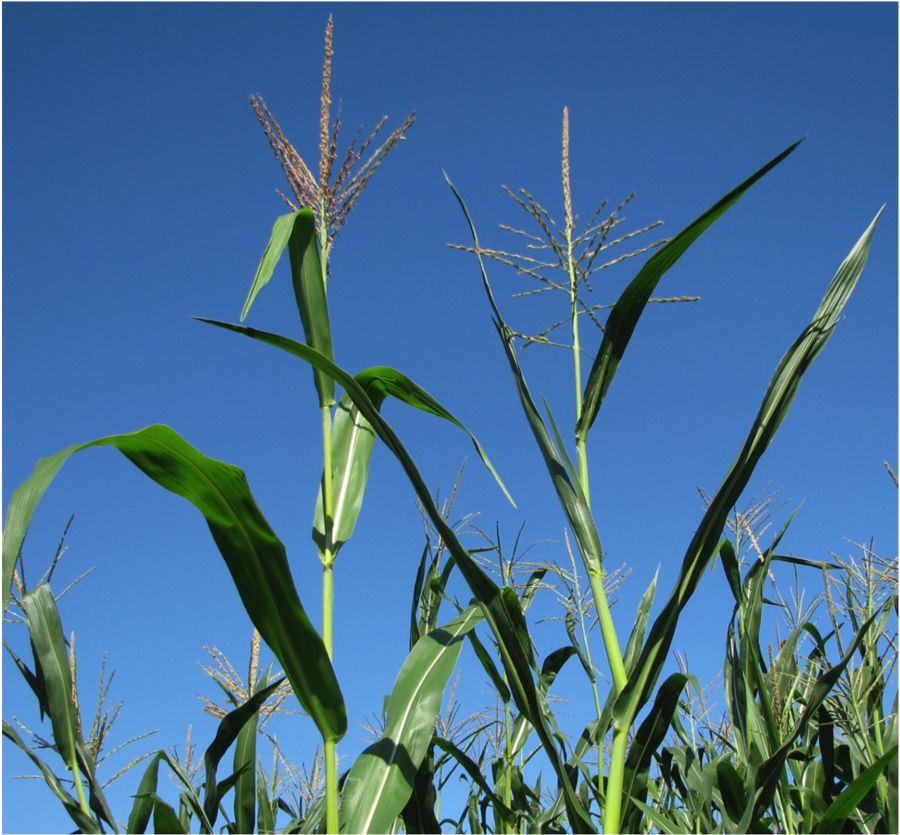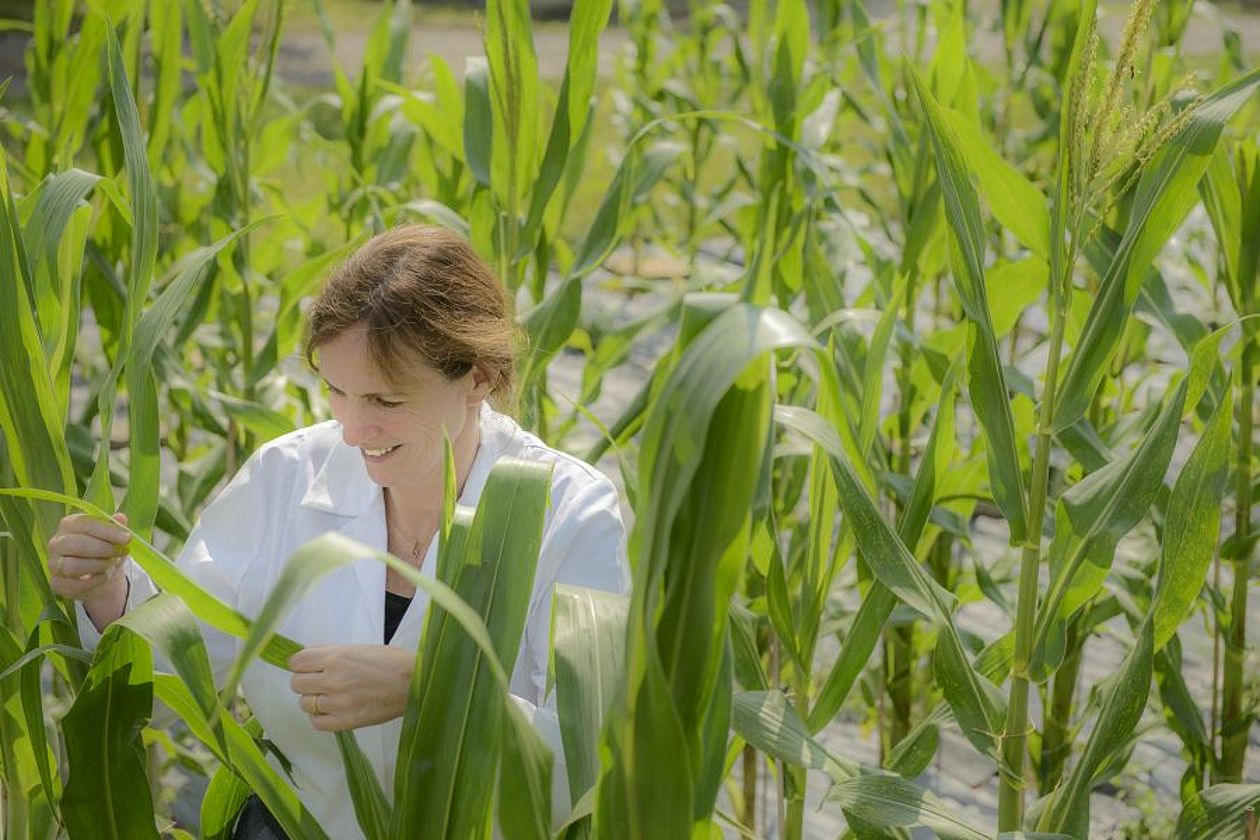Tübingen, Germany
December 9, 2019

Two maize lines with different leaf angle: Leaves on the plant on the left are more drooping and show a larger angle between the leaf and stem. The plant on the right has more upright leaves, and the angle to the stem is smaller. Leaf angle is a major agronomic trait, selected for to increase planting density and thereby yield.
Plants grow throughout their entire life. This is due to a small structure at the tip of the plant’s shoots, known as the meristem. This is the control center for the maintenance of stem cells – which can be converted into any cell type – and for the creation of plant organs such as side shoots and leaves. Although all plants have to carry out these basic tasks, the meristem is different in shape and size in differing species such as maize and thale cress. An international team of researchers headed by Professor Marja Timmermans of the Center for Plant Molecular Biology at the University of Tübingen has discovered that the meristem has even greater tasks than scientists had realized. It controls the architecture of the whole plant from the very tip. By mapping the genetic circuits involved in these functions in maize, the team has discovered key starting points for technological improvement of crops. Their results have been published in the journal Genome Research.
In multicellular organisms, cells have to communicate with each other in order to coordinate development. They recognize their position within the organism by creating and perceiving signal molecules; this enables them to decide which cell types are to be formed at which location. “Plants cannot move, yet they react with remarkable flexibility to changes in their environment,” says Timmermans. Her aim was to explore the role played by the meristem at the plant’s tip.

Marja Timmermans investigating a maize leave in a test corn field.
Adaptation to environmental conditions
The meristem at the tip of the shoot considers all kinds of developmental and environmental signals. Previously, it was assumed that the meristem only decided whether new stem cells or organs were to be formed. Working with her team, Timmermans has now precisely described the molecular circuits that are active in the cells of the meristem, drawing a roadmap of those circuits and describing each one’s functions. “Right out at the very tip, the meristem regulates the plant’s settings so that each individual grows into the optimal shape for the conditions it is located in,” she summarizes. “We identified mechanisms that specifically control the stem cells in maize, and have found that these also affect the overall architecture of the plant.”
These latest findings can be used for plant breeding and cultivation. “Maize yields have increased steadily over the last century. However, there was no significant increase in the number of grains produced per plant,” says Timmermans. “Rather, maize hybrids have been bred to thrive in denser plantations. The architecture of the maize plants, the angle and shape of the leaf play a vital role in the plant’s ability to efficiently catch the light and carry out high-performance photosynthesis. “The genetic circuits identified can now be used for further optimization,” Timmermans says.
Publication:
Steffen Knauer, Marie Javelle, Lin Li, Xianran Li, Xiaoli Ma, Kokulapalan Wimalanathan, Sunita Kumari, Robyn Johnston, Samuel Leiboff, Robert Meeley, Patrick S. Schnable, Doreen Ware, Carolyn Lawrence-Dill, Jianming Yu, Gary J. Muehlbauer, Michael J. Scanlon, and Marja C.P. Timmermans: A high-resolution gene expression atlas links dedicated meristem genes to key architectural traits. Genome Research, 29, 1962. https://dx.doi.org/10.1101/gr.250878.119
In der Spitze wird die Architektur der Pflanze angelegt - Forschungsteam unter Leitung der Universität Tübingen erstellt einen Atlas der Gene, die der Maispflanze Gestalt geben – Grundlage für biotechnologische Eingriffe
Pflanzen wachsen ihr Leben lang. Dafür sorgt ein kleiner Bereich teilungsfähigen Bildungsgewebes an der Sprossspitze, auch Meristem genannt. Dort sitzt die Steuerzentrale für die Aufrechterhaltung der in alle Zellarten wandelbaren Stammzellen und der Bildung von Pflanzenorganen wie Seitentrieben oder Blättern. Obwohl alle Pflanzen diese Grundaufgaben haben, sieht das Meristem bei verschiedenen Arten, wie etwa Mais und Ackerschmalwand, in Form und Größe unterschiedlich aus. Nun hat ein internationales Forschungsteam unter der Leitung von Professorin Marja Timmermans vom Zentrum für Molekularbiologie der Pflanzen der Universität Tübingen herausgefunden, dass die Aufgaben des Meristems weiter gehen als gedacht: Es steuert aus der Spitze heraus die Architektur der ganzen Pflanze. Bei der Kartierung der an diesen Funktionen beteiligten genetischen Schaltkreise bei Mais hat das Team entscheidende Ansatzpunkte zur technologischen Verbesserung von Nutzpflanzen entdeckt. Die Ergebnisse wurden in der Fachzeitschrift Genome Research veröffentlicht.
Bei vielzelligen Lebewesen müssen die Zellen untereinander kommunizieren, um die Entwicklung zu koordinieren. Über die Bildung und Wahrnehmung von Signalmolekülen erkennen sie ihre relative Position im Organismus und entscheiden so, welche Zellarten am jeweiligen Ort gebildet werden. „Pflanzen können sich nicht von der Stelle bewegen, doch reagieren sie auf Änderungen in ihrer Umgebung mit bemerkenswerter Flexibilität“, sagt Marja Timmermans. Sie wollte herausfinden, welche Rolle das Meristem an der Sprossspitze dabei spielt.
Anpassung an Umweltbedingungen
Das Meristem an der Sprossspitze berücksichtigt zahlreiche Entwicklungs- und Umweltsignale. Bisher hatte man angenommen, dass es nur entscheidet, ob neue Stammzellen oder Organe gebildet werden sollen. Gemeinsam mit ihrem Team hat Timmermans die molekularen Schaltkreise, die in den Zellen des Meristems wirken, in einem Atlas präzise beschrieben und ihre jeweilige Funktion bestimmt. „Dort in der äußersten Sprossspitze reguliert das Meristem die Einstellungen so, dass die individuelle Pflanze unter den jeweiligen Bedingungen zur optimalen Gestalt heranwächst“, fasst die Wissenschaftlerin die Ergebnisse zusammen. „Wir haben Mechanismen gefunden, die speziell die Stammzellen bei Mais steuern, und entdeckt, dass sie die Architektur der ganzen Pflanze bestimmen.“
Die neuen Ergebnisse lassen sich für Pflanzenzucht und -anbau nutzen. „Die Erträge im Maisanbau konnten im Laufe des letzten Jahrhunderts ständig gesteigert werden. Es wurden jedoch nicht bedeutend mehr Körner pro Pflanze produziert“, sagt Timmermans. „Vielmehr hat man Maishybride gezüchtet, die in dichteren Pflanzungen gedeihen.“ Dabei spiele die Architektur der Maispflanzen über den Winkel der Blattstellung und die Blattform eine entscheidende Rolle, um einen effizienten Lichteinfall und eine hohe Fotosyntheseleistung zu erzielen. „Die genetischen Schaltkreise, die wir identifiziert haben, lassen sich nun für die weitere Optimierung nutzen.“
Publikation:
Steffen Knauer, Marie Javelle, Lin Li, Xianran Li, Xiaoli Ma, Kokulapalan Wimalanathan, Sunita Kumari, Robyn Johnston, Samuel Leiboff, Robert Meeley, Patrick S. Schnable, Doreen Ware, Carolyn Lawrence-Dill, Jianming Yu, Gary J. Muehlbauer, Michael J. Scanlon, and Marja C.P. Timmermans: A high-resolution gene expression atlas links dedicated meristem genes to key architectural traits. Genome Research, 29, 1962. https://dx.doi.org/10.1101/gr.250878.119